Christian Streich is a rare breed. He is a manager who has been backed by his club’s board and allowed to work for a number of years and build something. Under his tenure, Freiburg have experienced everything from the highs of Europa League qualification to the lows of relegation into the 2.Bundesliga.
However, they are now a side thriving in the league. They are this season’s surprise packing, finding themselves only two points off the top of the table in the current campaign.
Admittedly they have had a relatively easy schedule, playing and beating the likes of Mainz, Paderborn, Fortuna Düsseldorf and Augsburg. Yet they still managed to draw with Borussia Dortmund and beat Hoffenheim suggesting they are a team that could compete in the upper echelons of the league this season. Disappointingly their only loss came in a home loss against relegation favourites Köln.
This tactical analysis will look into the tactics used by Streich with Freiburg.
Performance under Streich
Streich has overseen a total of 292 games winning 37.33% of these games. As mentioned earlier Freiburg were relegated in the 2014/15 season finishing 17th, but bounced back immediately the following season as champions finishing above RB Leipzig. In their six seasons in the Bundesliga under Streich they have only had two top-half finishes, finishing fifth and seventh in the 2012/13 and 2016/17 seasons.
Currently, they sit in fourth-place but statistics suggest they are perhaps fortunate to be in their current position.
Freiburg have been incredibly potent in front of goal so far this year, with only Bayern and Dortmund scoring more. But their xG for the season is just eight goals, but they have actually scored 15. Defensively they have only conceded less than top two, Borussia Mönchengladbach and Wolfsburg, with seven goals, but have an xGA of 8.9.
The expected points table has them sitting in ninth-place with a negative-one goal difference rather than their current fourth-place with a plus-eight goal difference.
Formations
Streich has grown in flexibility with formations as time has progressed in his Freiburg career. The 4-4-2 was used in 83% of Freiburg’s games in 15/16 and although he has continued to use this formation frequently in recent years, he began to show a proclivity for a 3-4-3 or even a 5-4-1. In fact this season he has only played with three at the back.
He has his front three play close to one another, leaving the flanks free for his wing-backs to provide width in attack as well as protect their own back three. By leaving so much space in the wings, this allows space for players to run into as Freiburg move forward. Streich likes to use the flanks to buildup attacks and Freiburg’s front three, as well as their centre-midfielders, are able to move into the spacious wide areas and link-up with their wing-backs.
Long-ball football
Streich’s philosophy revolves around playing in a direct but efficient manner. They rank fifth in the league for number of long balls played with 45.75 per 90 minutes, with a respectable if not outstanding 55.1% completion. They play a relatively similar amount of long balls to previous seasons under Streich but have never ranked in top five in the league before this year. This suggests that although Streich continues to use the long ball, the rest of the league are moving away from any such tendencies.
Streich’s team look to exploit space in behind defences and will use a traditional long-ball to the forward line looking for a quick header behind the backline. Subsequently one of Freiburg’s forwards is able to run onto the flick on and get behind the opposition defence.
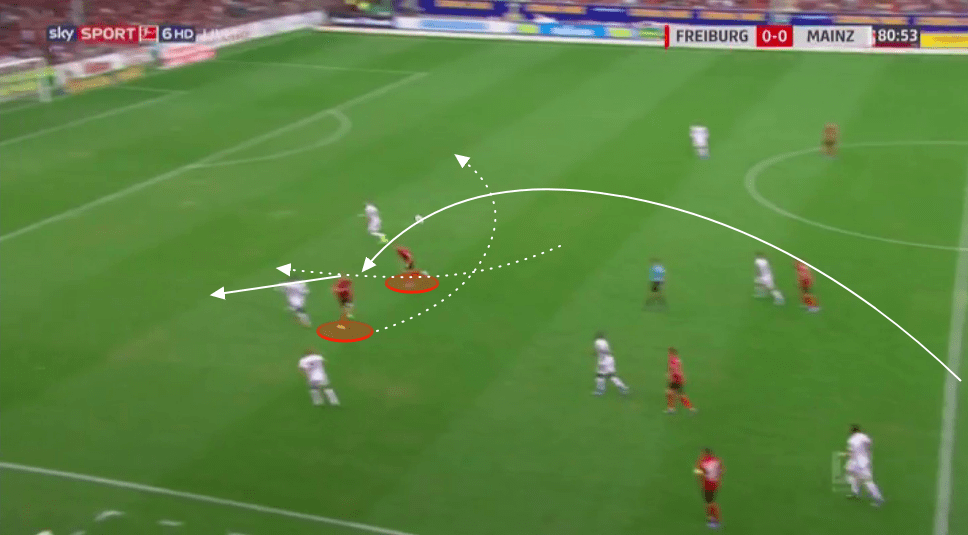
But it must be made clear that although this is an option they have used in the past, this is by no means their regular attacking intention. Regardless of what the passing statistics imply, Streich’s side are not a traditional long-ball team in any sense.
Streich looks to have his teams play out from the back but they are very purposeful in playing forward.
They don’t play a lot of passes. Last year they averaged only 360.17 passes per game, well below the league average of 419.82 last year. This year that’s down to an even lower number of 341.89, which again is below the league average of 412.13. Despite this, they have an 81.3% accuracy and last year it was 82.5%. They do generally have a smaller share of possession but these below-average pass stats are down to how quickly Streich wants his team to get the ball forward.
In the analysis below, we can see an archetypal Freiburg formation as they seek to play out from the back. The front three play close to one another, with the wing-backs playing high and wide. One centre-midfielder drops deep to provide a passing option, whilst one remains slightly higher, closer to the forward line should they look to play into them quickly. Streich uses his central defender from his back-three, Robin Koch, as a playmaker and tempo setter. And rather than playing long balls to the forward line, Koch is often used as a pivot for the side, albeit from the defence, and switches long balls to either flank.
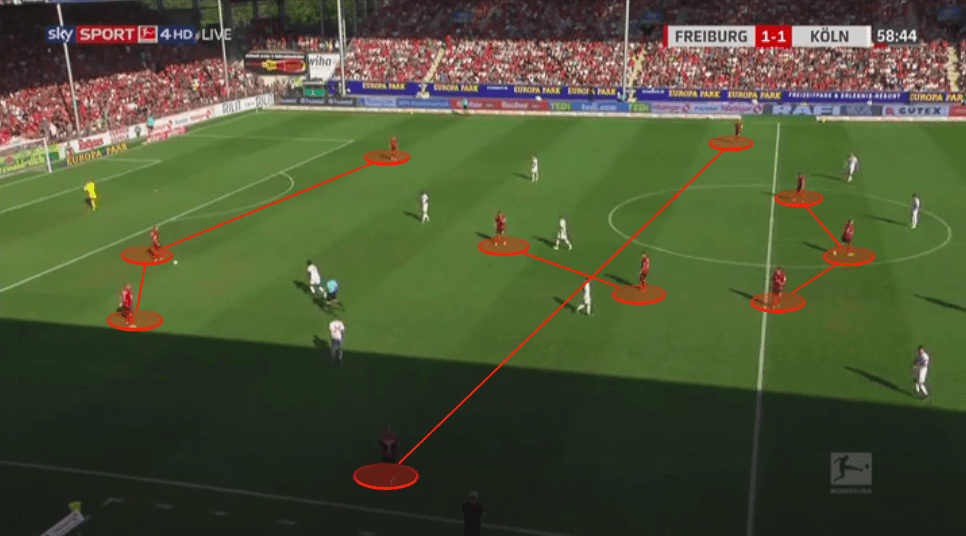
Koch is the side’s most frequent long passer, and ranks in the top 30 in the league for number of long passes per 90 minutes. Streich uses his back three to play the ball laterally before either going for the early long ball, most frequently to one of the wing-backs. Freiburg often look to build play down one flank before it is quickly recycled to Koch, who makes the long pass to the vacant side. When Freiburg look to penetrate one flank, the winger on the opposite side often stays as wide as possible to allow for this quick switch of play.
Streich greatly prefers using the wings to break teams down and create opportunities. He uses his centre-midfielders as enforcers who can break down opposition attacks, quickly recycle the ball, and are fit enough to swiftly move from side to side to assist in creating a numerical overload on the wings. Both Nicolas Höfler and Amir Abrashi are good at fulfilling this role, but neither are the type of players to play defence-splitting balls into their forward line.
Freiburg have only managed 5.66 through passes per game with a measly 28.6% accuracy. Over the last two seasons they have ranked in the bottom three for amount of through passes, and passes to the final third.
Although Freiburg do engage in a lot of long passes, it is more often than not to switch play to a wing-back with plenty of space to work in.
Player rotation in the opposition half
The majority of Freiburg’s buildup play in the opposition half is based around player rotation. Every run, movement, or pass by a player has been carefully choreographed on the training ground and drilled into this side until it is clockwork. Both Abrashi and Höfler make runs out of the middle onto the flanks ahead of their wingers. In doing so they create a passing option whilst also creating space for the winger to move into once he has passed the ball.
We can see an example of this below as the winger, Jonathan Schmid, receives the ball. He looks to play it down the line to his nearby teammate, Höfler, who has wandered into a wide position. This leaves the space inside open which he is able to penetrate in order to receive the ball once more.
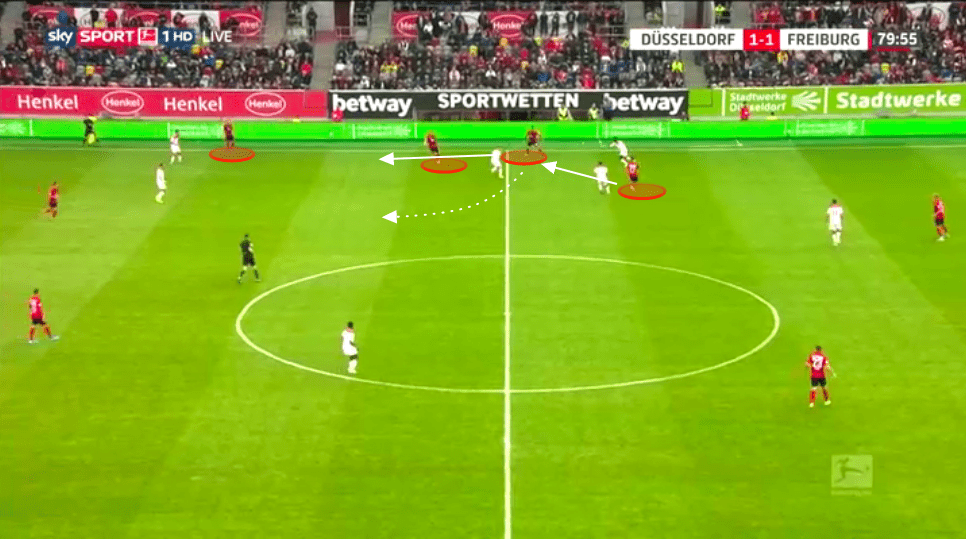
They look to build up in wide areas creating an overload on the offensive full-back. They do this through creating 3 v 2’s with quick interchanges. They look for these quick interchanges when the ball has been worked into the wide areas. Their wide forward and wing-back switch to create space and play behind the opposition defence.
Once again player rotation is key. As the forward has dropped deep to show for the ball, he has brought the Dortmund centre-back out of position leaving space behind. With a quick lofted ball, Schmid is able to move into the space vacated and get onto the end of the pass.
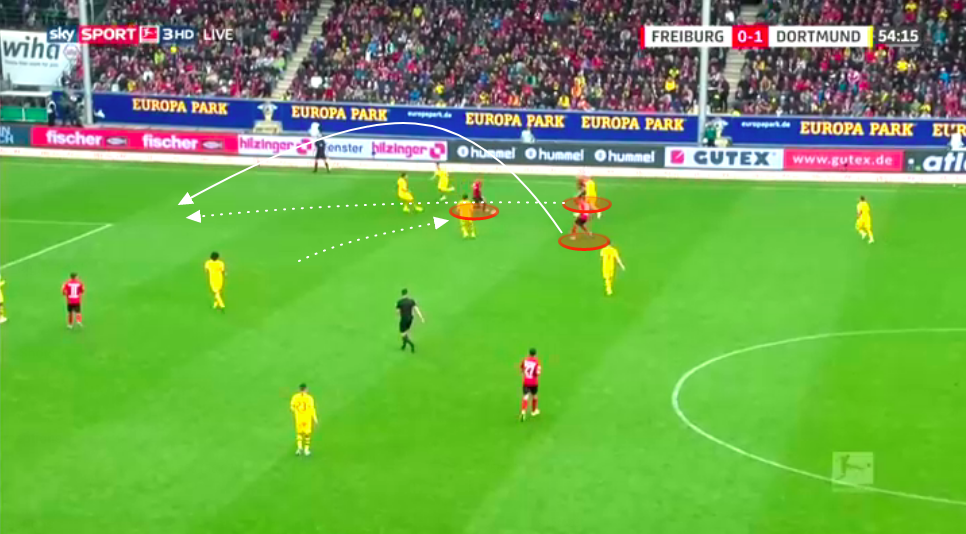
Streich’s wing-backs often look to receive the ball deep in the space between the opposition full-back and winger. As the opposition full-back presses, they look for one of their forwards or centre-midfielders to move into the space behind the defender, which they can play in to. Their pacey forwards constantly look to exploit space behind the defence.
Some of their rotational movements are very basic but effective. When forwards come into wide areas, the wing-backs will drive inside. As basic as it is, they make these movements so fast it is difficult for opposition defences.
In the example below, Freiburg forward Luca Waldschmidt moves into the flank. It creates space for wing-back Christian Günter to penetrate.
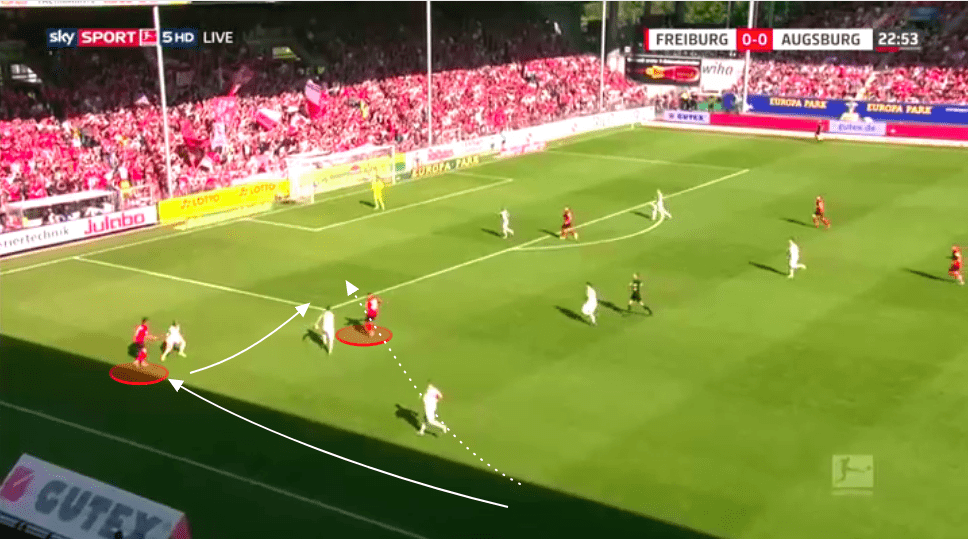
Defensive shape
With 3-4-3 being how Streich’s side has set up this season I am going to focus on this particular formation, rather than the 4-4-2 he has used in previous years.
Defensively, Freiburg look to hold their shape with the priority being to prevent the opposition from being able to pass through the central channels. Streich is happy to concede possession, and patiently defend, forcing the opposition to have to engage in patient buildup play should they wish to break them down. So far this season Freiburg have had an 11.73 PPDA, and last year were even lower with a 14.1 PPDA. For a league that has made gegenpressing an international phenomenon, Streich’s approach is against the grain.
With the opposition in possession, Streich has his side position themselves deep in their own half, with their wing-backs supporting their back three by creating a 5-2-3. By protecting the central channels they seek to force the opposition wide.
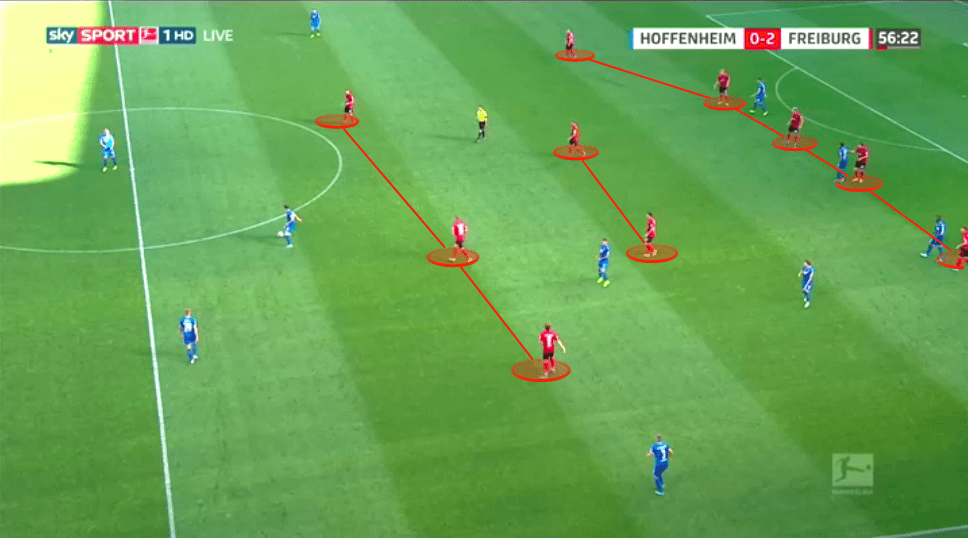
If they are defending in an even deeper position they will continue to drop back as a unit. In the below analysis, despite the ball being on the edge of their own 18-yard-box, they have eleven men back to defend. Their low central block has six players defending the threat from the middle of the pitch. Their back three will continue to play close together whilst one of Streich’s front three drops in to support the midfield two. What is striking is how the wing-backs occupy particularly wide positions.
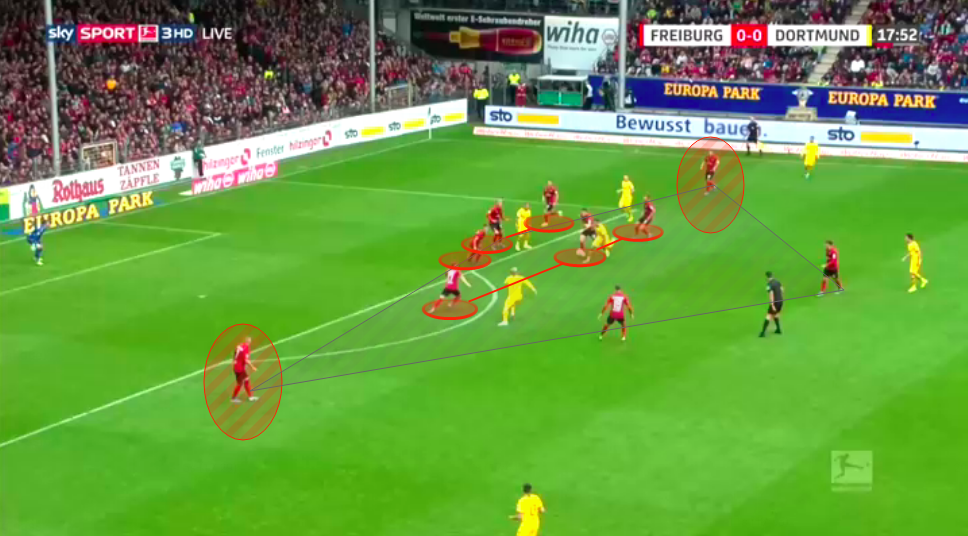
By taking these wide areas they nullify the threat from the opposition wingers. As the ball is so far advanced in their half there is little space for the opposition to play in behind, and even if the opposition takes that option, they can cover the small space behind them with relative ease. With so many players filling the central area, even if the opposition worked an opportunity to cross, Streich has positioned enough players defensively to make the defence firm favourites in an aerial battle.
This is a risky tactic and it does invite pressure. In their last four seasons in the Bundesliga, they have ranked in top five in the league for shots conceded. In each of these seasons, they have also had one of the leakiest defences in the league.
With so many players dropping deep to defend Streich wants to encourage teams to commit too many players to an attack. By packing the centre of the pitch, strategically placing their two wing-backs in these wide areas, and keeping two forwards deep but in central areas, they are set up to transition into a counter-attack. Freiburg are not short of pace both on their wings and within their front three. They are quickly able to turn defence into attack and will again seek out the long ball to do exactly this.
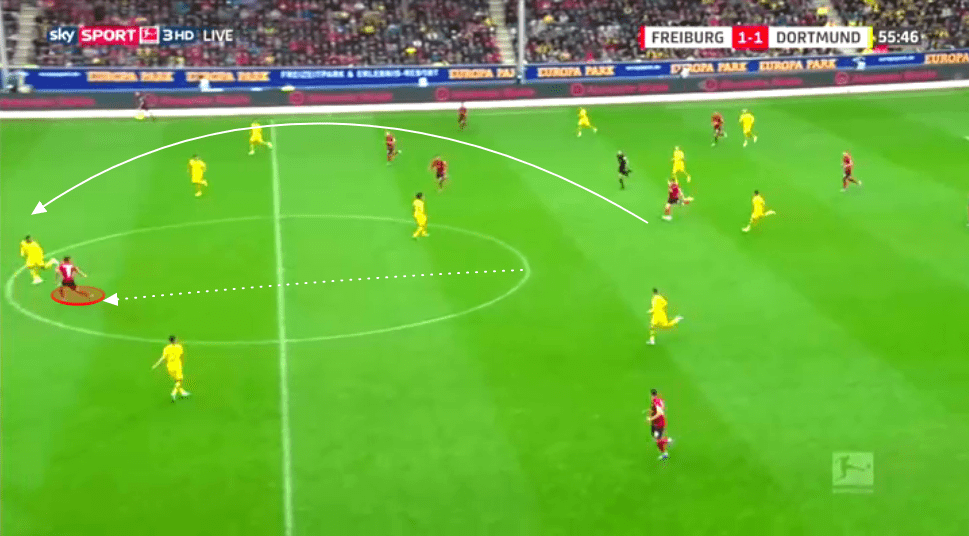
Where could they improve?
Freiburg aren’t a side that focus on creating 1v1 opportunities and their attempted dribbles per game as a side is one of the lowest in the league. However, as a side they have the second-highest percentage success rate for dribbles in the league this season with 56.2% completion. They have traditionally been one of the worst teams in the league for this ranking in the bottom four in their last three seasons, yet clearly there has been a marked improvement in this area. With improved success rate, either they are dribbling in better areas or this an area of untapped potential for this side.
Conclusion
Streich is held with the utmost regard by Freiburg fans, and other than one relegation, he has consistently kept Bundesliga football in Freiburg. In the ten previous seasons before Streich took over Freiburg had played five of those in the 2.Bundesliga.
Although evidence suggests that Freiburg might not end the season in the position they currently reside, we can see that Streich has formed a team with a clear philosophy, who deserve credit for their smart, forward-thinking, efficient football.
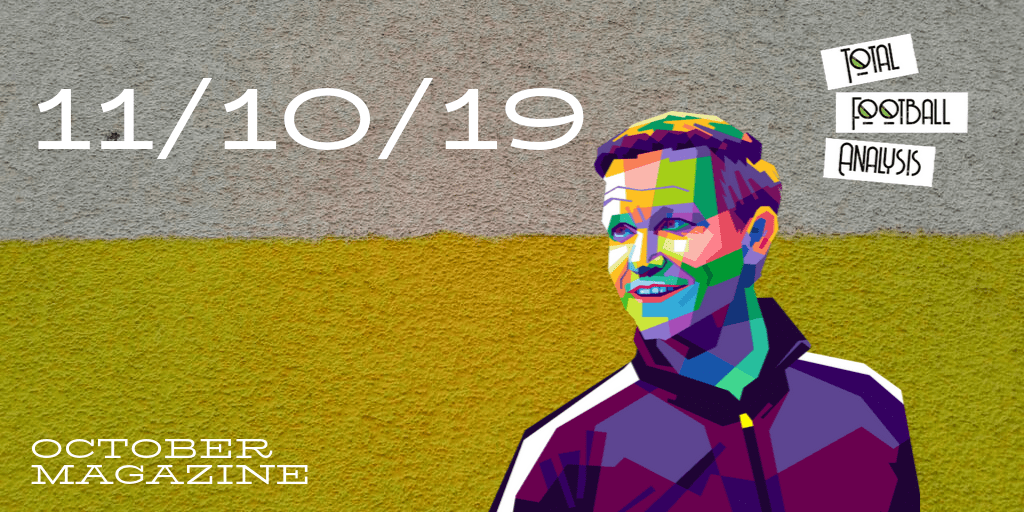
If you love tactical analysis, then you’ll love the digital magazines from totalfootballanalysis.com – a guaranteed 100+ pages of pure tactical analysis covering topics from the Premier League, Serie A, La Liga, Bundesliga and many, many more. Buy your copy of the October issue for just ₤4.99 here





Comments